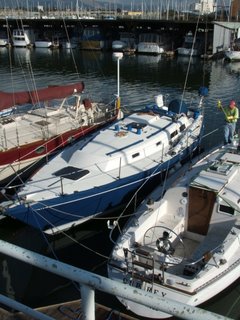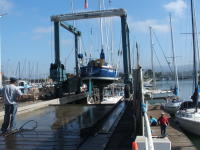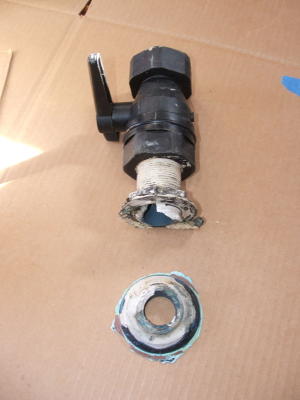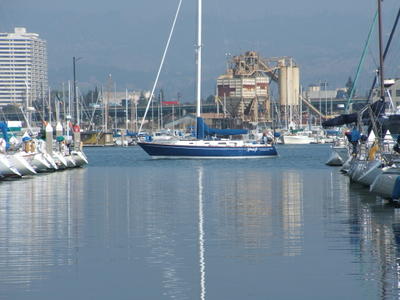5/11 - Synopsis of Refit Work (29 October 2006-11 May 2007)Bastress Custom Boats:Raymarine ST 6002 autopilot drive, tiller arm, and feedback control.
Newmar PT-25 three-stage “smart” battery charger, auto charge relay, DC energy monitor, and Balmar ARS-5 voltage regulator.
Rewire battery distribution system and navigation station, and relocate and rewire windlass and winch breakers.
Custom navigation station panel.
Recommended survey work (installed GFI on major AC outlet, fit plastic shield over AC breaker terminals behind electrical panel, replaced bilge pump switch, install dedicated CNG safety blowout line).
Star Marine Electronics:
Raymarine E80 navigation display in navigation panel and in cockpit and run wires.
Raymarine 24” 4kw Radar dome and run cables.
ST60 instrument pack (speed, depth, analog wind) in place of KVH display.
Raymarine ST6002 autopilot electronics.
Ocean Equipment AG215 rail guard with single bend and custom top and bottom rail guard plates.
Svendsen’s Boat Works:
Unstep mast, remove standing rigging, and remove wire-to-rope halyards.
Remove mast hardware, clean and paint mast, install two new electrical conduits and wiring, install radome with custom bracket, move deck light below radar, install new steaming light above radar, install LED tri-color anchor light, replace track cover on lower portion of mast, and install mast hardware.
Install new stainless deck collar.
Step mast, Spartite the mast, re-bed chain plate covers, and install new standing rigging.
Install new Ballenger boom with double line reefing system.
Install lazy jack system.
Install Samson warpspeed and XLS yacht braid halyards.
Install custom lazy jack system.
Remove some deck hardware; repair gelcoat; install new deck organizer, clutches for main sheet, main halyard, reef lines, and outhaul; install blocks; install Spinlock cleats for preventer and traveller.
Install and wire Andersen 40 STE winch.
Tune rig and make sail ready.
Haul, hang and launch for survey.
 11/2-3 -
11/2-3 - Svendsen’s unstepped the mast without any problems on Thursday, and Deb and I went up to the boat Friday afternoon to meet with all the folks involved in the refit work. Our friend Rob Bastress met us there. We went over the mast work with John Hanson, Svendsen’s rigging foreman, clarified what we’d be doing with it, and chose the new steaming light and combined mast-top tri-color and anchor light. We also met with Ron Jones of Star Marine Electronics and his installer, Kevin, and went over the installation of the chart plotter, instruments, and autopilot. Rob is doing the mechanical installation work on the autopilot, building a custom platform for the navigation station chart plotter repeater, and installing the new battery charger, so we worked all that out with him as well.

Since the mast was out and Svendsen’s wouldn’t be doing the deck work for a couple of weeks at least, Rob and I took the boat back to our slip.
More photos11/14 - Rob moved the boat from Marina Village to his work dock adjacent to Mariner Boat Yard to install the mechanical components for the autopilot. Meantime, Svendsen's continues to work on the mast.
11/18-21 - Dropped by the boat on Saturday to discover that the autopilot tiller arm was bored 2/10,000 to big and wobbled on the rudder post. Rob was pretty frustrated with the whole thing, and we agreed to move the boat back to our slip the next day for the Thanksgiving holiday period. By Tuesday I finally reached Star Marine and they agreed to go re-measure the post and take care of the problem. Meanwhile, Star's installer, Kevin, removed the old KVH Quattro instruments from the bulkhead.
10/29 - Started getting ready for our next refit, which will include removing the mast, installing a custom stainless deck collar, replacing the standing rigging and boom (our current boom has a bad crack at the outhaul adjustment), painting the mast, installing Raymarine radome, moving steaming and deck lights on the mast, replacing the VHF antenna and upgrading the cable and conduit, switching out wire halyards with rope and reversing the jib and main halyards, installing a line collector and Spinlock clutches and running the main halyard along with lines for a new double-line reefing system back to the cockpit on the port side, replacing preventer and traveler cam cleats with Spinlock PX cleats, replacing the KVH Quattro instrument system with a Raymarine ST60 Plus system, installing a Raymarine E-Series chart plotter with a repeater at the navigation table, installing an ST6002 below-deck autopilot, and installing a Newmar three-stage “smart” battery charger with a new monitor.
Today we removed the sails and stowed them in the V-berth, opened the cotter pins on the standing rigging, and generally got things ready to unstep the mast.
10/31 - I took the boat over to Svendsen’s Boatworks in the afternoon. Tony Oliver, who just moved his Cal 39-2
Chance into a slip directly behind us on our fairway, gave me a hand with the lines.
 11/27-12/1 -
11/27-12/1 - Star Marine’s installer, Kevin, returned the tiller arm after Star had it machined down a bit (not enough, but enough to work). Kevin worked on the electronics all week at our slip, and when we arrived Friday afternoon we discovered that he had not followed our instructions at all. They ordered a Lewmar guard rail guide for the steering pedestal (our’s is an Edson pedestal), so when installed, it forced the new guard rail and chart plotter mount to be moved three inches closer to the pedestal. Rather than call us about it, he simply drilled eight new holes on the cockpit sole to install the mounts for the guard rail and put it in. He simply left the old mounts for the old rail guard in place. Moreover, he did not cut down the rail to the height we’d agreed on.

Then we discovered he’d not installed the autopilot controller under the quarter berth, as we’d agreed, but saw a spot we’d cleared old wiring from to mount something else and simply mounted the controller there. Of course, on Friday afternoon we couldn’t reach them.
A big part of the problem, we think, is that the Star’s Ron Jones, who’s in charge of our project, went on a two-week vacation the end of November, so Kevin was left on his own. Anyhow, after a weekend of stewing and also realizing Ron had not sent us all the warranty cards for the electronics so we could file for a sizeable rebate (to have been postmarked November 30th), Deborah called Ron Jones at Star on Monday. He got an extension on the rebate for us, filled out the cards, and I got them out overnight mail today (December 5th). He’s also meeting us on December 8th to been correcting Kevin’s mistakes.
 12/1 -
12/1 - John Hansen, the rigging foreman at Svendsen's, has taken a new job (at Hansen Rigging in Alameda), and we met with him and his successor, Chris Tibbe, a very personable and seemingly knowledgeable fellow. We saw the mast ready for painting, the new boom, discussed what to do about winches, and then picked out the rope we will be using for halyards and reef lines.
 12/2 -
12/2 - Rob came over to our slip, and he and Deb took
Spindrift back to his work dock to complete installation of the autopilot mechanical parts. We also discussed mounting of the nav table chart plotter/radar unit.
12/8 - This week we connected with Star Marine’s Ron Jones and, after he visited the boat and saw the installation problems, he agreed without hesitation to make everything right. We met him at midday on the boat and went over all the issues. After he left, we agreed with Rob on how mounting the nav table chart plotter/radar unit. After a late lunch, we checked in with Chris Tibbe at Svendsen's, got a glimpse of our newly painted mast, and arranged for delivering the boat to their docks next week.
12/15 - Spindrift is still at Rob's work dock at Mariner Boat Yard. We are off on our Caribbean cruising vacation today, and won't be back until the new year. Rob assured us the boat would go over to Svendsen's in a week or so.
12/22 - Got a telephone call from Chris Tibbe, the new rigging foreman at Svendsen's.
Spindrift is not yet at his docks, but I told him that Rob promised it by the end of the week. Since it's almost Christmas, the work force will be down, but we agreed a week isn't going to matter here. We also told him, based on our experiences using lazy jacks in the Caribbean (over four trips now) that we wanted to install the Dutchman system rather than lazy jacks.
 1/10-19 -
1/10-19 - Remember, it's just a boat!! Soon after we returned from our Caribbean cruising holiday, we got a call the 10th from Rob who wanted to update us on the boat. He said it was still at his docks, Star Marine hadn't done much but relocated the autopilot control box, which they'd installed in the wrong place, and he was waiting to hear from Svendsen's as to a date to deliver it to their work dock.
Since we fully expected Rob to be done with his part, Star Marine to be much further along with the electronics installation, and the boat to be delivered to Svendsen's at least right after Christmas, saying I was irritated is perhaps too mild. Nevertheless, I swallowed my anger.
"Why didn't it go over to Svendsen's after Christmas?" I stammered. Chris Tibbe had told him they couldn't work on it - space problems, stormy weather had put them behind, and such - and they'd let him know when they could have it.
"Well," I said to myself, "it's a boat," and then I called Tibbe.
"Oh no, we've been ready for the boat all along," said Tibbe. He didn't know why Rob hadn't brought the boat over. Beginning to boil, I held my breath. "Okay, I'll let Rob know you're ready and get it to you right away."
Now, Rob's a true craftsman who's work we deeply admire. We joke that
Spindrift is as much his boat as ours for all the work he's done on her, and over time Deb and I have become truly good friends with Rob, sailing together, going to the Caribbean together, and engaging in some deeply personal conversations. Still, it's hard to mix business and friendship sometimes and this was one of those moments. Nonetheless, I held my rage when I called.
"He's calling me a liar," Rob blustered. "I'm going to go have words with him!"
"Look, I don't know what happened, but obviously it's a misunderstanding," I said, trying to be smooth over my own anger.
After a few more back and forths and assuring each other our friendship was first in this, Rob said he'd get the boat over on the 15th. Since we were jetting off to Panama for five days, there was much more we could do. I called back Tibbe and told him to expect the boat.
On the 16th, the morning after we returned from our trip, Rob called. The boat was at Svendsen's. I was knocked down by a cold which I most likely ingested on our flight back from the Caribbean on AA's elongated-tubular-recirculating-petri
dish, and which further flights on similar vehicles between California and Panama had not helped, so I thanked him and said I'd call him later in the week.
On the 17th, Star Marine called to get approval for a part being fabricated (hell, we told them "yes" before we left in December), and I was to drugged up to do more than say "yes" again.
Next day, Tibbe called from Svendsen's. Problem. Scanvik in Florida, the importers for Andersen winches, can't get the cabin top winch for four weeks. Did we want to wait (it was already five weeks behind on the delivery schedule) or get another brand? And also, what sort of mast collar do you want? "I'll fax you some sketches."
The next morning, I called him back. Stick with the Andersen winch. We'll wait. Meantime, since there's a delay, our insurance wants a survey this year. Please arrange for a noon-time hang and an insurance survey in the next three or four weeks. Also, get the mainsail over to Doyle to get it fixed for the Dutchman system. We'll take the middle range collar.
1/20-2/13 - Work on Spindrift moves along...slowly. The autopilot is installed (except for hooking up the wires). Rob did a lovely job creating a level mount for the linear drive unit, which was not straightforward since the rudder post has a 10 degree angle toward the bow and the aft cockpit seat onto which the mount had to be attached had a 5 degree angle aft The photo to the right, looks up at the short stroke drive unit. The mount Rob created is made of two pieces of marine grade ply and is painted white.

The photo on the left shows the linear drive attached to the tiller arm which in turn is attached to the rudder post.

Other work completed includes the installation of a new Newmar PT-25 three-stage smart battery charger and Blue Sea battery link ACR (automatic charging relay). A Newmar DC energy monitor replaces the old charger amp monitor on the instrument panel inside the boat. Rob also got the interior radar panel put together nicely, which involved relocating the VHF and the stereo and relocated the fuses so they are accessible.

Ron Jones of Star Marine also completed installation of the new pedestal guard and radar unit, which had been installed incorrectly a month before. The new guard required fabrication of guard rail guide, which we had done out of polished stainless steel, and a stainless mounting plate. Give credit to Ron, who really listened to us when he discovered that his installer Kevin had screwed up the first installation. He did a lovely job, and the height is good for both Deborah and me.
Meantime, Svendsens completed the mast work - it should be stepped in a week or so, as soon as the mast collar is completed. They've also stripped off the deck hardware that is being replaced, and pulled down the cabin headliner. A bit of a problem there, unfortunately, because it may not be possible to reinstall the headliner properly because there is not enough to stretch it back. They'll do their best, but in the end, we may need to have a new headliner made. If we do, we'll make a new one in such a way that it can easily be removed in the future.


 2/28 -
2/28 - Another two weeks and things continue to creep along. The Andersen winch we've been waiting on should arrive at the importers shop in Florida on March 9th, and they say they'll ship it right along. Once it arrives, Svendsen's can proceed with the deck work.

The mast is still not stepped. The yard is waiting on the metal shop to polish the new stainless collar, which they've been promising for two weeks. To fill the time, I arranged to have
Spindrift surveyed, fulfilling a request sent along by our insurance carrier a month ago. I retained Peter Minkwitz (right in photo with Rob Bastress). Several years ago he turned to surveying after being yard foreman at Svendsen's for 15 years. Turns out that when he was at Svend's he trained Rick Krep, who was a top notch surveyor himself and who I hired to survey my
Islander Dog Days when I bought it in 2000.

I arranged for a noon hang and drove up to be there when Peter did his work. Rob Bastress wanted to come by as well, and so he lent a hand moving
Spindrift from her slip at Svend's to the lift. Her bottom was dirty, but the year-and-a-half year old bottom paint was in really nice shape (good thing, because Svend's had no room to put her up for painting if she needed it), and a power wash was all that she needed. While she was hanging, Kevin from Star Marine installed the transducers for the new instruments, and I had the yard put new zincs on the shaft and strut.

Svend's rigging foreman Chris Tibbe said he didn't think the mast would be ready to go up until the next week, so we arranged to take the boat over to Rob's docks beside Mariner Boatyard so he could finish up a couple things he'd been doing in the refit. And Rob and I agreed on his completing a couple of things Peter found needing attention in the survey.
I let Rob drive her over to his docks, while I went by car and met him to side tie her to another project boat Rob's working on. Later I dropped Rob off at his truck at Svend's.
3/4-3/20 - Survey Report dated March 2, 2007 showed
Spindrift to be in very good condition for her age. Rob Bastress completed the survey recommendations requiring work at his docks, which included replumbing the CNG vent, installing a GFI outlet to cover the galley and head and port side, installing a safety cover over the AC breaker terminals, and replacing the bilge pump switch and rewiring the bilge pump.

On Monday, March 12th, Rob returned
Spindrift to Svendsen’s, where the mast was stepped on Tuesday. Rob completed all the refit work for which he was responsible, and we made final payment to him on Friday.
Saturday Deborah and I agreed on installing a new ICOM 402 VHF with a command mic in the cockpit, for which Star Marine was already running the wire. Star Marine completed all the wiring from the mast to the instruments by Tuesday, March 20th, and we made final payment to them.
3/20-5/11 - We left for a two week sailing vacation in the BVIs on March 23. I talked with the rigging foremen Chris Tibbe about finishing up the standing rigging and the deck work while we were gone. When we returned we found that nothing had been done, and the yard was using the delayed shipment of the Andersen winch as their excuse.
We should have known – “the squeaky wheel gets the grease” – and I made it my business to go up to the yard virtually every day after April 11th. That plus my speaking directly to the yard owner Sven Svendsen lit a fire under things. The Andersen winch arrived, and Tibbe and his assistant Noah worked on the boat almost every day for the next three weeks.

And, my time going up wasn’t wasted, since after my daily visit to the yard I spent the day re-doing the varnish on my Islander Bahama 28,
Dog Days.We brought
Spindrift back to her berth on May 11th. The next week I went in and negotiated a rebate on the yard bill, which made us feel a lot better about the overall cost of the refit work.
Additional refit photos










 12/1 - John Hansen, the rigging foreman at Svendsen's, has taken a new job (at Hansen Rigging in Alameda), and we met with him and his successor, Chris Tibbe, a very personable and seemingly knowledgeable fellow. We saw the mast ready for painting, the new boom, discussed what to do about winches, and then picked out the rope we will be using for halyards and reef lines.
12/1 - John Hansen, the rigging foreman at Svendsen's, has taken a new job (at Hansen Rigging in Alameda), and we met with him and his successor, Chris Tibbe, a very personable and seemingly knowledgeable fellow. We saw the mast ready for painting, the new boom, discussed what to do about winches, and then picked out the rope we will be using for halyards and reef lines.














